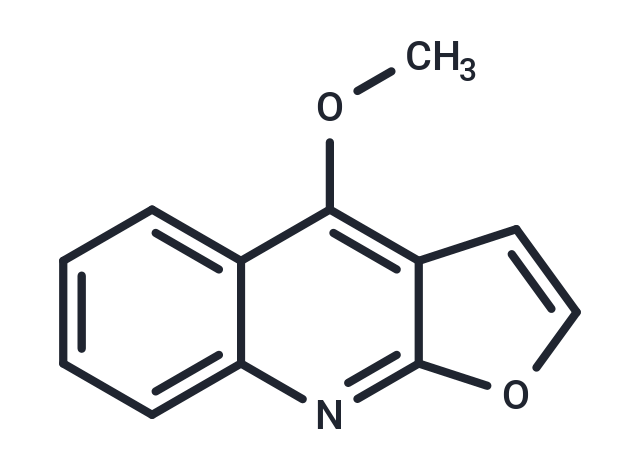Shopping Cart
- Remove All
 Your shopping cart is currently empty
Your shopping cart is currently empty

Dictamine (Dectamine) shows anticholinesterase, anti-inflammatory, mutagenic, and has antimicrobial activity against bacteria and fungi. It has the ability to exert cytotoxicity in human cervix, colon, and oral carcinoma cells.

| Pack Size | Price | Availability | Quantity |
|---|---|---|---|
| 20 mg | $82 | In Stock | |
| 1 mL x 10 mM (in DMSO) | $45 | In Stock |
| Description | Dictamine (Dectamine) shows anticholinesterase, anti-inflammatory, mutagenic, and has antimicrobial activity against bacteria and fungi. It has the ability to exert cytotoxicity in human cervix, colon, and oral carcinoma cells. |
| In vitro | Dictamnine has antimicrobial activities against the model fungus Saccharomyces cerevisiae, with a minimum inhibitory concentration (MIC) value of 64 microg/ml[1].Dictamnine(Dic) induced S phase cell cycle arrest at low concentration and cell apoptosis at high concentration in which loss of mitochondrial membrane potential (Δψmm) was not involved. Inhibition of caspase-3 using the specific inhibitor, z-DQMD-fmk, did not attenuate Dic-induced apoptosis, implying that Dic-induced caspase-3-independent apoptosis. Combination treatment with DHA and Dic dramatically increased the apoptotic cell death compared to Dic alone. Pretreatment with z-DQMD-fmk significantly attenuated DHA and Dic co-induced apoptosis, implying that caspase-3 plays an important role in Dic and DHA co-induced cell apoptosis. Dic induced S phase cell cycle arrest at low concentration and cell apoptosis at high concentration in which mitochondria and caspase were not involved and DHA enhanced Dic induced A549 cell apoptosis via a caspase-dependent pathway[2]. |
| In vivo | Dictamnine showed different anti-inflammatory effect in variety of animal models of anti-inflammatory[3]. |
| Kinase Assay | Commercial oligonucleotide microarrays were used to determine the global transcriptional response of S. cerevisiae triggered by treatment with dictamnine. We interpreted our microarray data using the hierarchical clustering tool, T-profiler. Several major transcriptional responses were induced by dictamnine. The first was the induced environmental stress response, mainly under the control of the Msn2p and Msn4p transcription factors, and the repressed environmental stress response in genes containing the PAC (RNA polymerase A and C box) and rRPE (ribosomal RNA processing element) motifs. The second was the Upc2p-mediated response involved in lipid biosynthesis. The third comprised the PDR3- and RPN4-mediated responses involved in multidrug resistance (MDR). Finally, the TBP-mediated response was induced with dictamnine treatment. TBP is an essential general transcription factor involved in directing the transcription of genes. Quantitative real-time RT-PCR was performed on selected genes to verify the microarray results. Furthermore, morphological transitions during dictamnine exposure to S. cerevisiae L1190 (MATa/alpha) were examined, using confocal laser microscopy[1]. |
| Animal Research | High performance centrifugal partition chromatography method was used for separation of the essential dictamnine,and anti-inflammatory effects of ethanol extracts and dictamnine were investigated by xylene-induced aruical swelling in mice and the abdominal capillary permeability in mice[3]. |
| Alias | Dictamnine, Dectamine |
| Molecular Weight | 199.21 |
| Formula | C12H9NO2 |
| Cas No. | 484-29-7 |
| Smiles | COc1c2ccoc2nc2ccccc12 |
| Relative Density. | 1.263 g/cm3 |
| Storage | Powder: -20°C for 3 years | In solvent: -80°C for 1 year | Shipping with blue ice. | |||||||||||||||||||||||||||||||||||
| Solubility Information | DMSO: 50 mg/mL (250.99 mM), Sonication is recommended. | |||||||||||||||||||||||||||||||||||
Solution Preparation Table | ||||||||||||||||||||||||||||||||||||
DMSO
| ||||||||||||||||||||||||||||||||||||

Copyright © 2015-2025 TargetMol Chemicals Inc. All Rights Reserved.